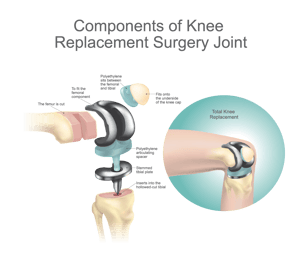If you’re familiar with osteoarthritis, or chronic knee pain, chances are you’ve heard of the dreaded knee replacement before. But, rarely do we hear about what this procedure actually consists of. In this blog post, we’ll explore what exactly a knee replacement is.
A knee replacement is a procedure to resurface a knee that has been damaged by osteoarthritis, or in some cases from a severe knee injury. The main goal of a total knee replacement is to resurface the areas of the knee joint that have been damaged, and to ease the knee pain that has not been able to be aided by other treatments.
To understand what happens during a knee replacement, it is important to understand the anatomy that makes up the knee joint. The knee joint, like other joints in the body, is made up of bones, muscles, tendons, and ligaments that allow the knee to function properly.
The Anatomy of the Knee Joint
Let’s take a closer look at the elements of the knee joint, and how the knee is able to function.
 First, there are two main bones that make up the knee joint. The tibia is the shin bone, or the larger bone of the lower leg. The femur is the thigh bone that makes up the upper leg. The femur extends from the knee joint all the way to the hip. The third and final bone that makes up the knee joint is the patella, which is also known as the kneecap.
First, there are two main bones that make up the knee joint. The tibia is the shin bone, or the larger bone of the lower leg. The femur is the thigh bone that makes up the upper leg. The femur extends from the knee joint all the way to the hip. The third and final bone that makes up the knee joint is the patella, which is also known as the kneecap.
Next, there is cartilage in the knee joint. Cartilage is a tissue that covers the surface of the bones in the knee joint that help to lessen friction during movement within the joint.
Then, there is the synovial membrane. The synovial membrane is a tissue that lines the entire knee joint and seals it into a “joint capsule.” The synovial membrane is also responsible for producing and secreting synovial fluid. Synovial fluid is extremely important to the knee joint, as it is responsible for providing lubrication to the knee. As we age, we begin to produce less and less synovial fluid, often leading to knee stiffness and discomfort.
Finally, the knee joint also consists of ligaments, tendons, and the meniscus. Ligaments are tough and elastic connective tissues that surround and support the joints. Ligaments also limit the movement of the joint, keeping the knee from overextending or twisting and causing injury. Tendons connect the muscles to the bones and help control movement. Lastly, the meniscus is a curved piece of cartilage that helps to absorb shock, increase the area of contact for bones and muscles, and also deepen the knee joint.
When Knee Replacements are Recommended
Knee replacements are often recommended for patients who are suffering from osteoarthritis. Osteoarthritis occurs when cartilage begins to break down within the knee or other joints. This can be extremely painful and cause swelling and stiffness, making it difficult to move and go about day to day life.
Knee replacements are commonly recommended for cases of moderate to severe osteoarthritis, as a way to eliminate pain. However, studies show that over 1/3 of knee replacements that are recommended are actually medically inappropriate. Additionally, knee replacements actually only last 10-15 years, and can last even less depending on a number of factors, including weight and level of activity.
However, when a knee replacement is recommended, it is important to know what exactly the procedure is.
The Knee Replacement Procedure
The knee replacement procedure could more accurately be called a knee resurfacing, as only the surface of the bones is actually replaced during the procedure. This process consists of four major steps:
- Preparation of the Bone. During this step, the damaged cartilage at the ends of the femur and tibia are both removed, along with a small amount of the underlying bone of the surface.
- Positioning of Metal Implants. During this step, the removed cartilage and bone is replaced with metal components that serve to recreate the surface of the joint. These metal parts may be either cemented into the joint, or pressed on, depending on the part itself.
- Resurfacing of the Patella. This is a step that can be omitted by the surgeon, depending on the case. In this step, the area under the surface of the patella is cut and resurfaced with a plastic button.
- Insertion of the Spacer. The final step in the knee replacement procedure consists of a medical grade plastic spacer that is inserted between the metal components that are now in the knee, which creates a smooth gliding surface.
Knee Replacement Recovery
The procedure of knee replacements has a number of risks associated with it, which you can read about here. But, even if all of these risks are avoided, there is still a lengthy recovery and rehabilitation process that goes along with a knee replacement, that can last anywhere from 4-12 months. And, for patients who opt for a knee replacement at a younger age, they will have to go through the entire procedure and recovery process again 10-15 years after their initial replacement (depending on weight, activity level, and several other factors).
Non-Surgical Solutions
If you have been considering a knee replacement for you or a loved one, it is not your only option. Flexogenix® offers non-surgical solutions for osteoarthritis and joint pain that have helped over 40,000 patients avoid knee replacements. Contact us today for a no-cost consultation and let us give you a personalized treatment plan to eliminate your knee pain and improve your life!






